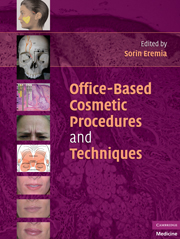Book contents
- Frontmatter
- Contents
- PREFACE
- CONTRIBUTORS
- PART ONE ANATOMY AND THE AGING PROCESS
- PART TWO ANESTHESIA AND SEDATION FOR OFFICE COSMETIC PROCEDURES
- PART THREE FILLERS AND NEUROTOXINS
- Chap. 6 FILLERS: PAST, PRESENT, AND FUTURE
- Chap. 7 HYALURONIC ACID FILLERS: HOW STRUCTURE AFFECTS FUNCTION
- Chap. 8 RESTYLANE: GENERAL CONCEPTS
- Chap. 9 THE RESTYLANE FAMILY OF FILLERS: CANADIAN EXPERIENCE
- Chap. 10 THE JUVÉDERM FAMILY OF FILLERS
- Chap. 11 PURAGEN: A NEW DERMAL FILLER
- Chap. 12 PURAGEN: ASIAN EXPERIENCE
- Chap. 13 REVIEW OF COLLAGEN FILLERS
- Chap. 14 HUMAN AND BOVINE COLLAGEN-BASED FILLERS
- Chap. 15 PORCINE COLLAGEN: EVOLENCE
- Chap. 16 CALCIUM HYDROXYLAPATITE (RADIESSE): A FACIAL PLASTIC SURGEON'S APPROACH
- Chap. 17 CALCIUM HYDROXYLAPATITE (RADIESSE): A DERMASURGEON'S APPROACH
- Chap. 18 CALCIUM HYDROXYLAPATITE FOR HAND VOLUME RESTORATION
- Chap. 19 LONG-LASTING FILLERS: HOW STRUCTURE AFFECTS FUNCTION
- Chap. 20 ACRYLIC PARTICLE–BASED FILLERS: ARTEFILL
- Chap. 21 POLY-L-LACTIC ACID FILLERS
- Chap. 22 POLY-L-LACTIC ACID (SCULPTRA) FOR HAND VOLUME RESTORATION
- Chap. 23 BIOALKAMIDE
- Chap. 24 SILICONE
- Chap. 25 AUTOLOGOUS FAT TRANSFER: AN INTRODUCTION
- Chap. 26 SMALL-VOLUME FAT TRANSFER
- Chap. 27 LARGER-VOLUME FAT TRANSFER
- Chap. 28 FAMI TECHNIQUE AND FAT TRANSFER FOR HAND REJUVENATION
- Chap. 29 ADDING VOLUME TO THE AGING FACE: FAT GRAFTING VERSUS FILLERS AND IMPLANTS IN EUROPE
- Chap. 30 FILLERS: HOW WE DO IT
- Chap. 31 CHOOSING A FILLER
- Chap. 32 FILLER COMPLICATIONS
- Chap. 33 NEUROTOXINS: PAST, PRESENT, AND FUTURE
- Chap. 34 BOTOX: HOW WE DO IT
- Chap. 35 COSMETIC BOTOX: HOW WE DO IT
- Chap. 36 BOTOX: BEYOND THE BASICS
- Chap. 37 BOTOX FOR HYPERHIDROSIS
- Chap. 38 DYSPORT
- Chap. 39 NEUROTOXIN ALTERNATIVE: RADIOFREQUENCY CORRUGATOR DENERVATION
- Chap. 40 FILLERS AND NEUROTOXINS IN ASIA
- Chap. 41 FILLERS AND NEUROTOXINS IN SOUTH AMERICA
- PART FOUR COSMETIC APPLICATIONS OF LIGHT, RADIOFREQUENCY, AND ULTRASOUND ENERGY
- PART FIVE OTHER PROCEDURES
- INDEX
- References
Chap. 33 - NEUROTOXINS: PAST, PRESENT, AND FUTURE
from PART THREE - FILLERS AND NEUROTOXINS
Published online by Cambridge University Press: 06 July 2010
- Frontmatter
- Contents
- PREFACE
- CONTRIBUTORS
- PART ONE ANATOMY AND THE AGING PROCESS
- PART TWO ANESTHESIA AND SEDATION FOR OFFICE COSMETIC PROCEDURES
- PART THREE FILLERS AND NEUROTOXINS
- Chap. 6 FILLERS: PAST, PRESENT, AND FUTURE
- Chap. 7 HYALURONIC ACID FILLERS: HOW STRUCTURE AFFECTS FUNCTION
- Chap. 8 RESTYLANE: GENERAL CONCEPTS
- Chap. 9 THE RESTYLANE FAMILY OF FILLERS: CANADIAN EXPERIENCE
- Chap. 10 THE JUVÉDERM FAMILY OF FILLERS
- Chap. 11 PURAGEN: A NEW DERMAL FILLER
- Chap. 12 PURAGEN: ASIAN EXPERIENCE
- Chap. 13 REVIEW OF COLLAGEN FILLERS
- Chap. 14 HUMAN AND BOVINE COLLAGEN-BASED FILLERS
- Chap. 15 PORCINE COLLAGEN: EVOLENCE
- Chap. 16 CALCIUM HYDROXYLAPATITE (RADIESSE): A FACIAL PLASTIC SURGEON'S APPROACH
- Chap. 17 CALCIUM HYDROXYLAPATITE (RADIESSE): A DERMASURGEON'S APPROACH
- Chap. 18 CALCIUM HYDROXYLAPATITE FOR HAND VOLUME RESTORATION
- Chap. 19 LONG-LASTING FILLERS: HOW STRUCTURE AFFECTS FUNCTION
- Chap. 20 ACRYLIC PARTICLE–BASED FILLERS: ARTEFILL
- Chap. 21 POLY-L-LACTIC ACID FILLERS
- Chap. 22 POLY-L-LACTIC ACID (SCULPTRA) FOR HAND VOLUME RESTORATION
- Chap. 23 BIOALKAMIDE
- Chap. 24 SILICONE
- Chap. 25 AUTOLOGOUS FAT TRANSFER: AN INTRODUCTION
- Chap. 26 SMALL-VOLUME FAT TRANSFER
- Chap. 27 LARGER-VOLUME FAT TRANSFER
- Chap. 28 FAMI TECHNIQUE AND FAT TRANSFER FOR HAND REJUVENATION
- Chap. 29 ADDING VOLUME TO THE AGING FACE: FAT GRAFTING VERSUS FILLERS AND IMPLANTS IN EUROPE
- Chap. 30 FILLERS: HOW WE DO IT
- Chap. 31 CHOOSING A FILLER
- Chap. 32 FILLER COMPLICATIONS
- Chap. 33 NEUROTOXINS: PAST, PRESENT, AND FUTURE
- Chap. 34 BOTOX: HOW WE DO IT
- Chap. 35 COSMETIC BOTOX: HOW WE DO IT
- Chap. 36 BOTOX: BEYOND THE BASICS
- Chap. 37 BOTOX FOR HYPERHIDROSIS
- Chap. 38 DYSPORT
- Chap. 39 NEUROTOXIN ALTERNATIVE: RADIOFREQUENCY CORRUGATOR DENERVATION
- Chap. 40 FILLERS AND NEUROTOXINS IN ASIA
- Chap. 41 FILLERS AND NEUROTOXINS IN SOUTH AMERICA
- PART FOUR COSMETIC APPLICATIONS OF LIGHT, RADIOFREQUENCY, AND ULTRASOUND ENERGY
- PART FIVE OTHER PROCEDURES
- INDEX
- References
Summary
Clostridium botulinum is the Gram-positive soil bacterium most famous in the cosmetic world for its ability to produce the highly sought after neurotoxins. Seven serotypes of C. botulinum exist, each giving rise to an antigenically distinct botulinum toxin, botulinum neurotoxin (BoNT) type A, B, C1, D, E, F, and G (serotype C2 exists but is cytotoxic and not neurotoxic). All toxins have the ability to bind to motor nerve terminals, become internalized, and block the release of acetylcholine (Ach). However, a complex interplay of several factors, including toxin serotype, potency, duration of action, preparation, volume of dilution, and protein load, creates variation among the neurotoxins. Of the seven distinct neurotoxin serotypes, BoNT type A has been the most scrutinized, studied, and therapeutically successful commercially available form.
The history of how this deadly toxin became available to use as medicine is fascinating and includes work done by many dedicated and astute physicians and scientists. The toxic effect of botulinum toxin was first noted in 1822 by a German physician, Kerner, who described food poisoning caused by ingestion of sausages. It was not until some years later, in 1895, that a Belgian microbiologist, Professor van Ermengen, identified that a bacterium producing a neurotoxin was the cause of botulism in Belgium musicians who became ill after eating sausages. Progress in research was possible after researchers, including Professor Ed Schantz and his colleagues, purified botulinum toxin A in sufficient amount for research.
- Type
- Chapter
- Information
- Office-Based Cosmetic Procedures and Techniques , pp. 145 - 150Publisher: Cambridge University PressPrint publication year: 2010



